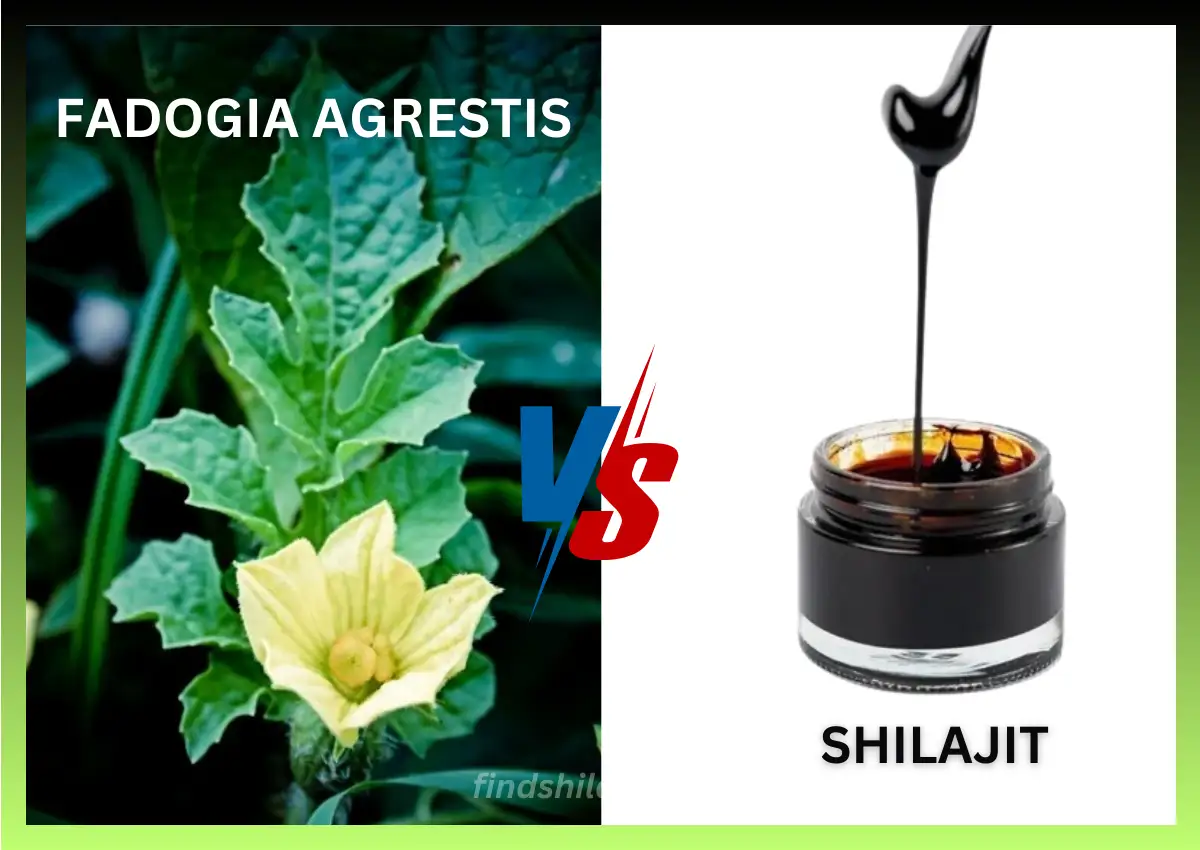After more than a year working in men’s health and sports performance, I’ve seen hundreds of supplements come and go.
Some create hype for a few months; others stick because they deliver real, measurable results to us.
Did You Know?
Shilajit’s fulvic acid can improve nutrient absorption by up to 40%.
Two names that consistently spark questions from athletes, professionals, and even men just looking to boost vitality are Fadogia Agrestis vs Shilajit.
I’ve tested both, tracked my client feedback, and dug deep into the research, from animal studies to human clinical trials.
While both are marketed as natural testosterone boosters, their origins, mechanisms, and long-term effects couldn’t be more different. If you’re wondering which one deserves a place in your supplement stack, let’s break it down from both science and real-world experience.
What is Fadogia Agrestis?
Fadogia agrestis is a shrub native to Nigeria and parts of Africa, long used in traditional medicine for one main reason—it’s considered a potent aphrodisiac.
The plant contains alkaloids, saponins, and glycosides, compounds believed to signal the body to increase testosterone production in men and women.
When I first tested Fadogia Agrestis, the effects were noticeable within days — a slight bump in energy, more drive during training, and a definite lift in libido.
This matches what animal research suggests: rat studies show higher testosterone levels and increased sexual behavior. The problem? There are no human trials to confirm these results, so we’re relying on anecdotal feedback and animal data.
From a safety perspective, there are concerns. High doses in animal studies have shown potential liver and kidney toxicity.
There’s no established safe dosage for humans, and supplement quality varies widely. When I recommend Fadogia to a client, it’s always for short cycles—four to eight weeks—and only from a brand with third-party lab testing.
Main Benefits of Fadogia agrestis
- Boosts Testosterone & Libido—In animal studies, Fadogia agrestis greatly increased testosterone levels (up to 6 times higher) and improved sexual desire. Its effects were stronger than some other well-known herbs.
- Supports Male Reproductive Health—Studies on rodents showed it could increase testicle size by 11–15%.
- May Improve Erection & Delay Ejaculation – Limited research suggests it may help maintain erections and increase time before ejaculation, which is unusual for aphrodisiacs.
- Potential Antimicrobial Effects – Lab studies found it may help fight some parasites, bacteria, and malaria.
- Antispasmodic Action – May help relax muscle spasms, based on lab research.
Side Effects of Fadogia Agrestis
Limited human research. Potential side effects: digestive upset, nausea, or possible liver/kidney stress at high doses. Always choose lab-tested supplements.
Recommended Dosage
Usually 300–600 mg per day. Cycle use (e.g., 4–8 weeks on, then break) due to limited safety data. If you still want to know how much shilajit par day you should use read here.
What is Shilajit?
Shilajit is a resin-like natural substance that drips out from rocks in the Himalayas, Altai, and Caucasus mountains after centuries of plant and mineral decomposition.
It’s rich in fulvic acid, humic acid, and over 80 trace minerals, including zinc, magnesium, and iron — all essential for male and female health.
My first Shilajit trial didn’t deliver the instant “kick” I felt with Fadogia. Instead, the changes were subtle and built over time — steadier daily energy, faster recovery between workouts, and a noticeable improvement in focus and mood. By week three, the difference in training endurance was clear.
Unlike Fadogia, Shilajit is backed by human clinical studies. A well-known 90-day trial published in Andrologia showed significant increases in total and free testosterone in healthy men.
Purified Shilajit is considered safe for long-term use, but raw or unprocessed Shilajit can contain heavy metals and should be avoided.
Benefits of Shilajit
- Energy & Stamina: Supports ATP (Adenosine Triphosphate) production for better physical and mental energy.
- Hormone Support: May naturally boost testosterone in men and balance hormones in women.
- Cognitive Function: Linked to improved memory, focus, and brain health.
- Mineral Replenishment: Provides essential trace minerals missing from modern diets.
Side Effects of Shilajit
Pure, tested Shilajit is generally safe, but impure or unprocessed resin can contain heavy metals. Possible mild side effects: increased urination, slight dizziness, or upset stomach in sensitive users.
Recommended Dosage
Typically, 300–500 mg per day of purified Shilajit extract. Start low and increase gradually.
I only recommend resin or capsule forms from reputable suppliers who provide lab reports.
Also Read: Moringa vs Shilajit Which one is the best?
Differences Between Fadogia Agrestis and Shilajit
Over the years, I’ve learned that these two supplements are not competitors in the traditional sense—they serve different purposes.
Fadogia is a short-term hormonal spark, while Shilajit is a long-term vitality builder. Fadogia’s effects are more immediate, but they fade quickly after you stop taking it.
Shilajit works gradually, with results that compound over time.
| Parameter | Fadogia Agrestis | Shilajit |
| Type | African herbal shrub | Mineral-rich mountain resin |
| Origin | Nigeria and other parts of Africa | Himalayas, Altai, Caucasus mountains |
| Main Active Compounds | Alkaloids, saponins, glycosides | Fulvic acid, humic acid, 80+ trace minerals |
| Primary Use in Tradition | Aphrodisiac and sexual health tonic | Energy, anti-aging, overall vitality |
| Main Claimed Benefits | Boosts testosterone, improves libido, increases training drive | Increases testosterone, boosts energy and stamina, improves recovery, supports brain health |
| Scientific Evidence | Mostly animal studies, no strong human trials | Multiple human clinical trials |
| Speed of Results | Fast (within days) but short-lived | Slow build (weeks) but long-lasting |
| Duration of Effect | Temporary, fades after stopping | Sustained with continued use |
| Best For | Short-term boost in libido or drive | Long-term health, stamina, recovery |
| Safety Profile | Unknown long-term safety; possible organ stress in high doses (animals) | Safe when purified; centuries of traditional use |
| Side Effects | Possible liver/kidney toxicity (high dose in animals), dosage unclear | Rare digestive upset; risk of contamination if unprocessed |
| Form Available | Capsules, powder | Resin, capsules, powder, gummies |
| Long-Term Use | Not recommended without breaks | Safe for daily use (purified) |
| Effect on Athletic Performance | Short bursts of energy/intensity | Improves endurance, recovery, oxygen use |
| Anti-Aging Benefits | Little to no evidence | Strong antioxidant profile, slows cell aging |
| Nutrient Value | Low — mostly plant compounds | High — 80+ minerals, supports nutrient absorption |
| Cost | Often higher per gram due to limited supply | Varies — resin most potent, capsules more affordable |
| Availability | Limited; seasonal harvest | Widely sourced in several countries |
| Legal in Sports | Yes (may face future regulation) | Yes (no known restrictions) |
| Stacking Potential | Often paired with Tongkat Ali or zinc | Works well with ashwagandha, ginseng, creatine |
| Sustainability Concerns | Risk of overharvesting in Africa | Can be sustainable if harvested carefully |
Which Works Better for Testosterone?
From a purely evidence-based perspective, Shilajit is the clear winner. Many human studies show it can raise both total and free testosterone, often alongside improvements in sperm quality and energy levels.
Below is an image of shilajit results from many customers who used shilajit from a direct brand on Amazon.
Fadogia Agrestis may boost testosterone—animal data suggests it can—but until human trials confirm it, those results remain speculative.
From my own testing and Amazon customer feedback, Fadogia’s testosterone-boosting effects, if present, seem strongest in the first few weeks. Shilajit’s effects are more gradual but longer-lasting.
Below is a reference image for one brand that has good feedback on the Amazon store
Which is safer, Shilajit or Fadogia?
Safety is where my recommendation often becomes decisive. Purified Shilajit, used daily, is well tolerated by most men.
The main risk is buying unprocessed material that contains contaminants. Fadogia Agrestis is more of an unknown.
There’s no human safety data for long-term use, and high doses in animals have caused organ stress. For this reason, I never suggest taking Fadogia continuously. But you can take shilajit in small quantities daily, but you have to take advice from your healthcare specialist before use.
Can You Take Fadogia and Shilajit Together?
Absolutely yes, because you take Shilajit and Fadogia together. Shilajit improves mitochondrial energy production and nutrient absorption. Fadogia stimulates luteinizing hormone, increasing testosterone; combined, they support energy, hormone levels, and performance through complementary mechanisms.
In some cases, it’s strategic and effective. I’ve had clients use Shilajit daily as a foundation for energy and overall health, then add Fadogia in short bursts when they want an extra edge in libido or drive, for example, leading up to a sports competition or during a specific training phase. If you go this route, consult a healthcare provider and monitor your body’s response.
Nutrient Profile Comparison
Fadogia agrestis is essentially a plant-based hormonal stimulator—it doesn’t deliver minerals or broad nutritional value like shilajit. Shilajit, on the other hand, is a nutrient powerhouse.
It’s 80+ trace minerals and high fulvic acid content not only support hormone health but also improve nutrient absorption from food and other supplements. This is why I often use Shilajit as the base in a supplement stack.
Fadogia Agrestis vs. Shilajit: Impact on Athletic Performance
In the gym, Fadogia feels like a short burst of aggression and motivation, useful for high-intensity phases but less relevant for long-term endurance in your body.
Shilajit plays the long game. Supporting mitochondrial energy production, it helps improve oxygen efficiency and recovery.
Over a month or more, that translates into better overall performance and fewer days lost to fatigue.
Longevity and Anti-Aging Potential
If your goal is long-term health and cognitive performance, Shilajit is in another league. In Ayurveda, it’s classified as a rasayana, or rejuvenator, used for centuries to slow aging and boost resilience.
Fadogia doesn’t have a comparable historical record or evidence for anti-aging effects.
Cost and Availability
Fadogia is often pricier per gram due to its limited harvesting regions, and availability can be inconsistent.
Shilajit is more widely available, though pure resin commands a higher price than capsules or powders.
In my opinion, paying for the resin is worth it for potency and purity.
Synergy With Other Supplements
Fadogia pairs well with Tongkat Ali for a stronger testosterone boost, but I wouldn’t combine it with multiple other hormonal stimulants.
Shilajit is incredibly versatile — I’ve stacked it with ashwagandha and ginseng to improve energy, recovery, and mental clarity, often with better results than those supplements on their own.
My Verdict—Which Should You Choose?
If you asked me to recommend one to a client for long-term use, I’d say Shilajit without hesitation.
It’s safe, proven, and offers benefits far beyond testosterone support. If you’re curious about Fadogia Agrestis, treat it as a short-term experiment, not a lifestyle staple. And if you want the best of both worlds, use Shilajit daily and cycle in Fadogia for short periods when you want an extra push.
FAQs
Which is better for boosting testosterone, Shilajit or Fadogia?
Fadogia may give a quicker boost (based on animal studies), while Shilajit offers more long-term hormonal support backed by human research.
Can I take Shilajit and Fadogia together?
Yes, many combine them—Shilajit supports energy and recovery, and Fadogia may enhance testosterone. Always consult a doctor first.
Is Fadogia safe for long-term use?
Long-term safety isn’t well studied. Most experts suggest cycling it (4–8 weeks on, then a break).
Does Shilajit work for women, too?
Yes, it can help with energy, mood, and nutrient support in women, not just men.
How soon will I see results?
Some notice benefits in 1–2 weeks with Fadogia, while Shilajit may take 3–6 weeks for full effects.
Final Takeaway
The Shilajit vs Fadogia Agrestis debate isn’t about picking a winner for everyone — it’s about matching the supplement to your goal.
Fadogia is the quick spark. Shilajit is the steady flame. I’ve seen both work, but for most men aiming for sustainable energy, performance, and hormonal health, Shilajit is the smarter long-term choice.
Also Read: Shilajit vs Tongkat Ali vs Fadogia – Which One Is Best for Your Body?
References:
Disclaimer
This article is for informational purposes only. Please consult a licensed healthcare provider before starting any new supplement, especially if you are pregnant, breastfeeding, or on medication.



